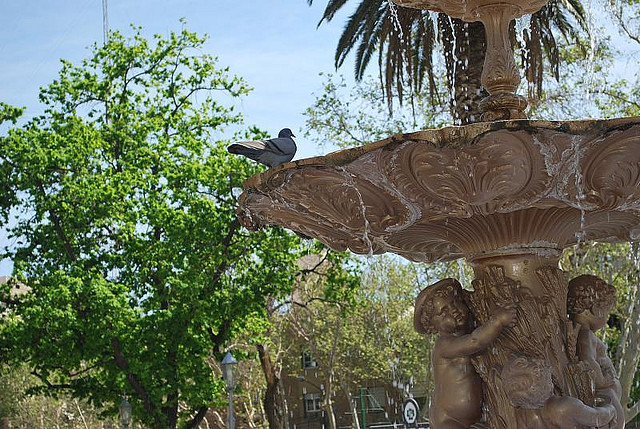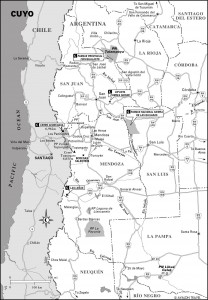
Fountain in the Plaza 25 de Mayo. Photo © Gabriel Gallardo, licensed Creative Commons Attribution.

Cuyo and Córdoba
San Juan de la Frontera dates from 1562, but its modern aspect stems from repeated earthquakes. The event with the greatest impact—and not just seismically—was the 1944 temblor that brought Juan Domingo Perón, then a minor political figure, to prominence for his disaster-relief efforts. Perón used this role as a springboard to found the controversial political movement known formally as Justicialism but more commonly as Peronism.Though smaller, poorer, drier, and hotter than Mendoza, San Juan has much in common with the larger city: wide tree-shaded avenues, sidewalk cafés, a wine industry that’s lifting the local economy, and a work schedule that starts early but shuts down for several hours in the smothering summer heat. It has been less successful in diversifying its economy, which is largely administrative and agricultural.
San Juan was the birthplace and home of statesman, educator, and author Domingo F. Sarmiento, who wrote the famous polemic Civilization and Barbarism about the excesses of provincial caudillos.
San Juan (pop. 115,556, elev. 650 meters) is 168 kilometers north of Mendoza via RN 40, and 1,138 kilometers northwest of Buenos Aires; the Avenida Circunvalación ring road keeps through traffic out of the city center. Its relatively small population is misleading as, like Mendoza, it’s the center of a larger metropolitan area (which exceeds 400,000).
Occupying a full block, Plaza 25 de Mayo is the civic center; north–south Calle Mendoza and east–west Avenida San Martín divide the grid into quadrants. Street addresses all have cardinal points to simplify orientation, but the outskirts are more irregular.
Lushly landscaped Plaza 25 de Mayo is a handsome central plaza, with its palms, fountains, and statuary, but buildings like its brutalist Iglesia Catedral (Mendoza and Rivadavia) seem to have been designed primarily to withstand earthquakes, despite some appealing details. For a panorama of the area, take the elevator (US$1) to the top of its 53-meter clock tower.
One block west and one block north, the Celda Histórica de San Martín (Laprida 57 Oeste, 4–7 p.m. Mon.–Sat., US$0.50), where the general stayed while raising funds and shoring up support for his daring Chilean campaign, is the only part of the colonial Convento de Santo Domingo to survive the 1944 earthquake.
Barely a block farther west, the Casa Natal de Sarmiento (Sarmiento 21 Sur, tel. 0264/422-4603, 8:30 a.m.–1:30 p.m. and 5–9:30 p.m. Tues.–Fri. and Sun., 8:30 a.m.–1:30 p.m. Sat., US$1.35), Domingo F. Sarmiento’s boyhood home, was the first building ever declared an Argentine national monument. Despite provincial origins that might have made him a caudillo, Domingo Faustino Sarmiento (1811–1888) became a renaissance man with a distinguished public career as an educator, journalist, diplomat, and the first president from Argentina’s interior provinces. While exiled in Chile during the Rosas dictatorship, he wrote the anticaudillo polemic Civilization and Barbarism, often subtitled Life in the Argentine Republic in the Days of the Tyrants and still in print in many languages.
Dating from 1801, built by Sarmiento’s mother Paula Albarracín, Sarmiento’s birthplace grew in time from the original one-room adobe to a 12-room brick house with two patios and a fig tree that appears prominently in his memoir, Recuerdos de Provincia. It suffered earthquake damage in 1944 but underwent a successful restoration.
Where Laprida meets Avenida España, at Plaza Julieta Sarmiento, covering 2.5 blocks, the Centro Cívico structure was a decades-long corruption-plagued project that was finally finished in time for Argentina’s 2010 bicentennial, and the result is not too bad.
Two blocks north of the Centro Cívico, beyond Plaza España, the former Estación Belgrano (railway station) is now home to the Centro Cultural María Eva Duarte de Perón (Avenida España and San Luis). One block farther north, the most worthwhile item at the Museo de Ciencias Naturales (Avenida España 400 Norte, tel. 0264/421- 6774, 9 a.m.–1 p.m. weekdays, free) is the reconstructed Herrerasaurus skeleton from Parque Provincial Ischigualasto. One block east and two blocks north, the Antigua Bodega Chirino (Salta 782 Norte, tel. 0264/421- 4327, 11 a.m.–1 p.m. and 6–9 p.m. Tues.–Sat., 11 a.m.–1 p.m. Sun.–Mon.) is no longer a working winery—that moved out of town—but parts of the old facilities are a museum, and there is a tasting room.
One block south of the Centro Cívico, the Museo de la Memoria Urbana (Avenida España and Mitre, 9 a.m.–1 p.m. and 4–9 p.m. Tues.–Sun.) covers San Juan’s urban evolution, with special emphasis on the 1944 earthquake.
About one kilometer southeast of Plaza 25 de Mayo, two museums share a building at Avenida Rawson and General Paz, though both are due to move before press time. The Museo de Bellas Artes Franklin Rawson (Avenida Rawson 621 Sur, tel. 0264/422-9638, 8:30 a.m.–1 p.m. Mon.–Wed. and Fri., 8:30 a.m.–1 p.m. and 6–9 p.m. Thurs., 9 a.m.–1 p.m. Sat., free) boasts an impressive roster of works by 19th-century Argentine artists, including Rawson himself and Prilidiano Pueyrredón, plus modern figures like Antonio Berni, Raquel Forner, Lino Spilimbergo, and others.
The same building holds the Museo Histórico Provincial Agustín Gnecco (Avenida Rawson 621 Sur, tel. 0264/422- 9638, 8:30 a.m.–1 p.m. Mon.–Wed. and Fri., 8:30 a.m.–1 p.m. and 6–9 p.m. Thurs., 9 a.m.–1 p.m. Sat., free), which traces San Juan’s history from prehistory through the 19th century via archaeological artifacts and items like silverwork, furniture, wine technology, and coins.
Under the auspices of the Universidad Nacional de San Juan, the Museo Arqueológico Mariano Gambier (Calle 5 and Progreso, Rawson, tel. 0264/424-1424, 8 a.m.–8 p.m. weekdays, 10 a.m.–6 p.m. weekends, US$1.25) chronicles 8,000 years of pre-Columbian peoples in what is now San Juan Province. Relocated from the countryside to Rawson, the exhibits explore the region’s cultural evolution in depth through artifacts that include tools, ceramics, basketry, and mummies—well-preserved in San Juan’s hot dry climate.
The provincial Subsecretaría de Turismo (Sarmiento 24 Sur, tel. 0264/421-0004, 7:30 a.m.–8 p.m. daily winter, 7 a.m.–9 p.m. daily the rest of the year) has up-to-date hotel information and distributes a good city map plus brochures on destinations elsewhere in the province. An airport office is open for arriving flights only.
For motorists, ACA is at 9 de Julio 802 Este (tel. 0264/421-4245).
Cambio Santiago (General Acha 52 Sur) changes money; Banco de San Juan (José Ignacio de la Roza 85 Oeste) has one of many downtown ATMs.
Correo Argentino is at José Ignacio de la Roza 259 Este; the postal code is 5400. Locutorios and Internet outlets are on almost every block in the vicinity of Plaza 25 de Mayo.
Several agencies arrange excursions to destinations like Ischigualasto and Talampaya (La Rioja), including Mario Agüero Turismo (General Acha 17 Norte, tel. 0264/427-7278, [email protected]).
Laverap (Rivadavia 493 Oeste, tel. 0264/421-5747) handles the laundry.
Hospital Rawson (General Paz and Estados Unidos, tel. 0264/422-2272 for emergencies) is the public hospital.
Aerolíneas Argentinas (Avenida San Martín 215 Oeste, tel. 0264/422-5049) flies daily to Buenos Aires’s Aeroparque. LAN has begun flights here from Aeroparque on a trial basis.
San Juan’s Terminal de Ómnibus (Estados Unidos 492 Sur, tel. 0264/422-1604) has provincial, long-distance, and international services (though it’s usually necessary to change in Mendoza for Santiago or Viña del Mar/Valparaíso).
Sample destinations, times, and fares include Mendoza (2 hours, US$6), San Agustín del Valle Fértil (3.5 hours, US$10), Córdoba (8 hours, US$22), Santiago (Chile) or Valparaíso/Viña (9 hours, US$22), Tucumán (13 hours, US$39–45), Buenos Aires (16 hours, US$40–65), and Salta (17 hours, US$50–65).
A cab or remise to Aeropuerto Domingo F. Sarmiento (tel. 0264/425-0487), about 13 kilometers southeast of town via RN 20, costs about US$5–7.
For rental cars, contact Avis (Laprida 82 Este, tel. 0264/420-0571), at the Hotel Alkázar.
Excerpted from the Third Edition of Moon Argentina.